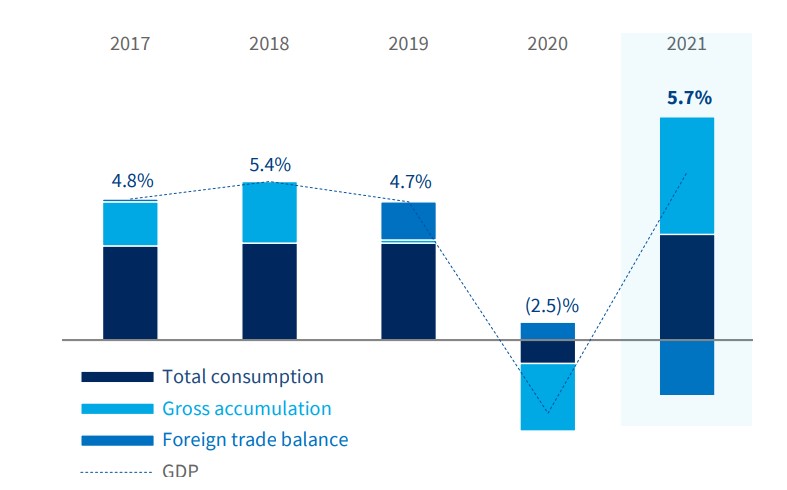Main trends in the Polish economy

Gross Domestic Product
According to Statistics Poland’s quick estimate, GDP grew by 5.7% y/y for the whole of 2021. Household consumption during this period increased by 6.2% y/y and investment by 7.9% y/y. The largest contributors to last year’s economic growth included: household consumption (which added 3.4 p.p. to the GDP growth rate), an increase in tangible current assets (+2.7 p.p.), gross fixed capital formation (+1.3 p.p.). In turn, the contribution of net exports was negative, having suppressed the GDP growth rate by 1.9 p.p.
Growth was supported by a strong increase in domestic demand - especially after the loosening of sanitary restrictions associated with the spring wave of the pandemic. This increase in deferred demand was made possible by government programs aimed at neutralizing the negative effects of the pandemic, and was facilitated by an accumulation of pandemic savings. Consumption was supported by a rapidly recovering labor market and robust wage growth, while the dynamic growth of investments by corporations was supported by their sound financial position, the prospect of economic recovery, and high levels of utilization of the production capacity. Widespread post-pandemic disruptions in global supply chains have also contributed to a marked increase in inventories. As a result, seasonally adjusted GDP exceeded the level recorded before the pandemic already in the second quarter of 2021, and its high quarter-over-quarter growth continued through the end of the year. In Q4 of last year, the level of seasonally adjusted GDP was 7.3% greater than in the corresponding quarter of 2020.
Decomposition of GDP growth in 2017-2021

Source: Source: Statistics Poland, preliminary estimate of GDP in Q4 2021 as at 28 February 2022
The economy weathered the sanitary restrictions of the early months of 2021 well and did not have to face them in the last quarter. Industrial production grew at an unexpectedly fast pace in 2021, benefiting from good business conditions for durable goods and showing surprising resilience to supply disruptions. In 2021, industrial output sold rose as much as 14.8% y/y after falling 1.0% in 2020 (data not adjusted for seasonality, Statistics Poland). Retail sales for the full year 2021 increased 8.1% (following a 3.1% y/y decline in 2020). The recovery of construction and installation output was slower, increasing by 3.2% y/y in 2021 (after a 2.2% y/y decline in 2020) (data not adjusted for seasonality, Statistics Poland).
Labor market and consumption
As the economy continued to recover in 2021, demand for labor has grown, accompanied by difficulties with finding qualified employees. This was reflected in a decline in the unemployment rate adjusted for seasonality and robust growth in wages.
For the entire 2021, the average monthly gross salary in the corporate sector increased in nominal terms by 8.8%. Given the increasing inflation, the purchasing power of salary rose in this period by 3.4% y/y. In terms of the whole national economy, the growth rate of wages was slightly lower than in the enterprise sector and stood at 8.4% y/y (3% y/y in real terms). At the same time, the average employment in the corporate sector increased by 0.3% y/y, and the data for the first three quarters of 2021 show that the growth in employment in the national economy as a whole was similar to that observed in the corporate sector (data from Statistics Poland). Data for the first three quarters of 2021 show that the salary growth in national economy as a whole was similar to that observed in the corporate sector.
Since March last year, the number of registered unemployed has gradually decreased, with a decline recorded even in December, when seasonal factors contribute to an increase in unemployment. According to Statistics Poland, the registered unemployment rate was 5.4% at the end of 2021. In December 2021, the seasonally adjusted rate of economic unemployment (according to Eurostat) stood at 2.9% (compared to 3.4% in December 2020), clearly below the European Union average (6.4%) and the euro area (7.0%).
In the improving situation in the labor market and rising incomes, consumer sentiments improved through September, favoring the realization of deferred demand. Consumption in the household sector in 2021 increased by 6.2%, after a 3% decrease in 2020.
Inflation, monetary policy and interest rates
In 2021, the consumer price index (CPI) increased on average by 5.1% in annual average terms, compared to 3.4% in 2020. The acceleration in the increase of prices of consumer goods was the result of supply shocks (including an increase in energy prices), a relatively weak zloty, but also a side effect of the success of macroeconomic policies aimed at supporting demand and economic growth. The rise in inflation was a global phenomenon - strong growth of demand collided with a limited supply of factors of production, and supply disruptions led producers to accumulate inventories.
In the first three quarters of 2021, the National Bank of Poland’s reference rate did not change, remaining at 0.1%. During this period, other central bank rates remained at the end-of-2020 levels. The NBP continued to make purchases on the secondary market for treasury bonds and treasury-guaranteed bonds (including bonds issued by the Polish Development Fund and Bank Gospodarstwa Krajowego), thereby supporting the liquidity of the domestic financial sector. These measures were aimed at counteracting the adverse economic effects of the COVID-19 pandemic and supporting economic growth. The strong increase in CPI inflation above the NBP’s inflation target (2.5%) since March and above the upper limit of the inflation target (3.5%) since April, ultimately led to decisive NBP interest rate hikes in Q4. The NBP's base interest rate rose by 40 bps in October, by 75 bps in November and by 50 bps in December. Thus, in total, in the fourth quarter (and throughout the year) the NBP reference rate increased by 165 bps, ending 2021 at 1.75%.
Public finance
As was the case in other countries, the COVID-19 pandemic and the measures taken by the government to minimize its effects resulted in an increase in the debt of the public finance sector. While public finance sector debt was only 45.7% of GDP in 2019, it rose to 57.5% of GDP in 2020 (Statistics Poland - ESA definition). Both real GDP and inflation growth in 2021 turned out to be visibly higher than the state budget assumptions. Therefore, the debt of the public finance sector to GDP in 2021 will most likely turn out to be lower than the 60.0% projected in the Convergence Program Update (APK) published last April (MF). According to forecasts published by the European Commission in November, the value of debt of the public finance sector is expected to decrease below 55% of GDP in 2021, while according to the Ministry of Finance (source: Budget Act for 2022), the estimated debt of the public finance sector in 2021, including non-budgetary expenditures (such as those earmarked for counteracting COVID-19), is expected to stand at approx. 57% (according to the ESA methodology).
The deficit in the general government sector (ESA), which in 2019 was 0.7% of GDP, increased to 7% of GDP in 2020 (Statistics Poland). According to APK, the public finance sector deficit in 2021 was expected to be 6.9% of GDP (MF). The markedly higher-than-assumed nominal GDP in 2021, however, contributed to higher-than-planned state budget revenues. Despite the continuation of additional government support in the first half of the year aimed at counteracting the negative effects of the pandemic, and despite the spring sanitary restrictions affecting economic activity, state budget actuals during the year regularly showed high surpluses compared to the corresponding periods in the previous year. As a consequence, the October budget amendment reduced the planned state budget deficit for 2021 by more than half (from PLN 82.3 billion to PLN 40.4 billion). Due to the lack of significant sanitary restrictions affecting the economic activity and financial situation of companies and households in the fourth quarter, the estimated budget performance for 2021 (according to the Ministry of Finance) also turned out to be better than the revised assumptions (only about PLN 26.3 billion deficit instead of the planned PLN 40,4 billion). As a result of the impact of the above factors, the general government deficit in 2021 could only amount to 5.3% of GDP (Ministry of Finance: Budget Act 2022)
